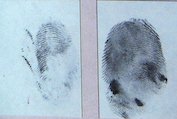Fingerprints
Fingerprint matching, particularly against large datasets, is very computer intensive. The processing power and the technical specifications of the equipment required for reliable fingerprint acquisition and matching is expensive.

The history of biometrics is closely associated with the need for police to reliably identify criminals. At first anthropometrics, using detailed records of their body measurements, physical descriptions and photographs, was considered reliable, until it was discovered that some people shared the same measurements.
In the early 20th century, with the introduction of a system that made it possible to index fingerprints manually, this became the biometric technology of choice. Fingerprints remain the premier biometric technology for police because it remains the most common form of biometric evidence left at crime scenes.

It has also been recognized that people who usually do intensive manual labour will not have fingerprints that can be used for biometrics matching.
Other causes leading to differing error rates include:
Advantages:
Disadvantages
More at:
Contextual information renders experts vulnerable to making erroneous identifications
Doctor 'used silicone fingers' to sign in for colleagues
Fake Finger Detection by Skin Distortion Analysis
Fingerprint biometrics
Fingerprint-Based Recognition
Fingerprint Recognition
Performance of Fingerprint Match-on-Card Algorithms
Fingerprint matching, particularly against large datasets, is very computer intensive. The processing power and the technical specifications of the equipment required for reliable fingerprint acquisition and matching is expensive.

The history of biometrics is closely associated with the need for police to reliably identify criminals. At first anthropometrics, using detailed records of their body measurements, physical descriptions and photographs, was considered reliable, until it was discovered that some people shared the same measurements.
In the early 20th century, with the introduction of a system that made it possible to index fingerprints manually, this became the biometric technology of choice. Fingerprints remain the premier biometric technology for police because it remains the most common form of biometric evidence left at crime scenes.

The acquisition of fingerprint data is critical to the success of this modality, and inability to appreciate this, has led to the failure of a number fingerprint matching systems. The equipment that acquires the fingerprints, and simultaneously checks data quality is expensive. Decision makers, tasked with authorizing the budgets are not aware that this is a critical success factor, and so choose proposals that rely on the manual collection of the fingerprints, using ink pads and paper.
It has also been recognized that people who usually do intensive manual labour will not have fingerprints that can be used for biometrics matching.
Other causes leading to differing error rates include:
- Environment - For instance, low humidity is associated with higher false rejection;
- Number of verification attempts - More attempts lead to lower false rejection, and higher false acceptance;
- Number of presentations allowed, and the decision policy - several images improves accuracy;
- Number of fingers used, and the fusion policy - images from two or more fingers improves accuracy;
- Demographics - Younger adult populations are widely considered to be easier to match;
- Habituation - Users who regularly interact with a system experience lower rejection rates;
- The sensor, and the enrollment policy - The application of quantitative quality criteria, e.g. in an auto-capture loop, improves error rates;
- The data format in use - Proprietary templates generally offer superior error rates to standardized formats[8], but are non-interoperable. Proprietary extensions to standard templates are similarly non-interoperable un- less executable code for each vendor’s extensions is built into the reader or read from the card.
Advantages:
- Subjects have multiple fingers
- Easy to use, with some training
- Some systems require little space
- Large amounts of existing data to allow background and/or watchlist checks
- Has proven effective in many large scale systems over years of use
- Fingerprints are unique to each finger of each individual and the ridge arrangement remains permanent during one's lifetime
Disadvantages
- Public Perceptions
- Privacy concerns of criminal implications
- Health or societal concerns with touching a sensor used by countless individuals
- Collection of high quality nail-to-nail images requires training and skill, but current flat reader technology is very robust
- An individual's age and occupation may cause some sensors difficulty in capturing a complete and accurate fingerprint image
More at:
Contextual information renders experts vulnerable to making erroneous identifications
Doctor 'used silicone fingers' to sign in for colleagues
Fake Finger Detection by Skin Distortion Analysis
Fingerprint biometrics
Fingerprint-Based Recognition
Fingerprint Recognition
Performance of Fingerprint Match-on-Card Algorithms